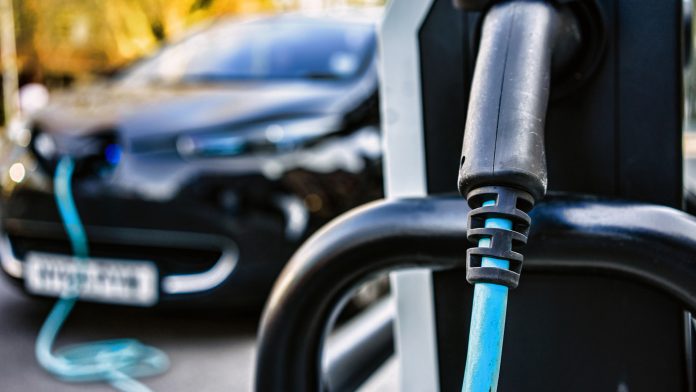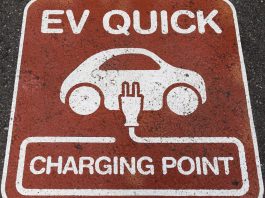The Innovation Platform speaks to EVA Scotland about their ambition to be the voice of the electric vehicle movement and to promote the decarbonisation of transport in Scotland.
Over the last 50 years, Scotland has been a major producer of oil with North Sea production reaching three million barrels per day in 1999 (approximately 4% of world production). Although oil production has decreased since then, it is still on a production plateau of around one million barrels per day.
Today, there is a shift from oil based transport fuels to electric transportation. Therefore, rather than filling up from a petrol or diesel pump at a service station forecourt, electric vehicle (EV) drivers in Scotland are increasingly likely to be filling up from a charge point fuelled by low carbon and renewable electricity at an EV charging hub.
The Scottish natural resource base for renewable energy generation is extraordinary by both European and global standards. Scotland is home to around 25% of Europe’s wind resource, 25% of Europe’s tidal energy resource and 10% of Europe’s wave resource. Scotland’s renewable electricity generating capacity is around 60GW, more than 10 times greater than the existing peak domestic demand. The exploitation of this resource is ongoing with Scottish Government targets for generating 100% of domestic electricity demand by 2020. There is no shortage of electricity in Scotland! In fact, Scotland is a major net exporter of electricity. Currently, most excess electricity is exported to England, however, plans for a North Sea Offshore Grid could see Scottish renewable electricity exported further afield.
The way to the decarbonisation of transport in Scotland
The Scottish Government has set a number of ambitious targets for decarbonisation of transport in Scotland. The key dates are 2032 to phase out the need for all new petrol or diesel cars and vans, 2035 to decarbonise Scotland’s railways and 2040 to make the Highlands and Islands the world’s first net zero aviation region. All on the way to the 2045 target of net zero carbon emissions.
In order to meet the 2032 target, the Scottish Government introduced a number of incentives and practical measures to encourage the general public to switch EVs. These include interest free loans for the purchase of new vehicles and additional grants to install smart domestic charge points. An interim target of 2025 has been set for public sector fleets. The Scottish Government have also funded a comprehensive and rapidly expanding ChargePlace Scotland electric vehicle charging network with 1,250 journey and destination chargers at present. The number of chargers on the ChargePlace Scotland network is expected to at least double in the near term. Chargers can be accessed using a single RFID card or via an ‘app’ with tariffs set by local hosts. It is by far the largest and most comprehensive electric vehicle charging network in Scotland and is expanding rapidly.
The exemplar city for EVs in Scotland is Dundee, highlighted by their Drive Dundee Electric campaign with funding from the Scottish government and Office for Low Emission Vehicles to encourage the uptake of ultra-low emission vehicles (ULEVS). Dundee has introduced three charging hubs in priority locations across the city region with a fourth hub planned. The hubs include multiple journey (rapid) and destination (fast) chargers and are amongst the most highly used chargers in Scotland. This in part is because 18% of taxis that operate in Dundee are electric. This figure is expected to reach 25% in the coming years. By autumn 2020 all three council multi-storey car parks will offer free parking for registered electric vehicles and over-night charging for local residents without off street charging on the top floor. In both charging hubs and roof top multi storey car park charging locations, solar canopies, LED lighting and static batteries provide a dry and well lit charging experience together with renewable energy generation and storage integrated with the local electricity grid. In addition, on street parking charging bays are free for all plug-in EVs to park while charging at four locations in the city. Dundee continues to innovate with vehicle to grid and on-street charging solutions. Dundee is host to car cub Co-wheels with electric vehicles ready to drive around the city 24/7. An electric bus service between Dundee and Edinburgh has just been announced. As a result of this impressive activity and infrastructure, Dundee was awarded the International ‘E-Visionary’ Award, by the World Electric Vehicle Association in 2018 after being nominated by EVA Scotland chair Alister Hamilton in the role of AVERE board member.
At 273 miles (439 km), the A9 is the longest road in Scotland. It runs from Polmont east of Falkirk in central Scotland all the way to Scrabster Harbour in Thurso, where the ferry leaves the northern tip of the Scottish mainland for Stromness in Orkney. Historically it was the main road between Edinburgh and John o’ Groats and has been called the “Spine of Scotland”. The Electric A9 will be Scotland’s exemplar EV infrastructure project with the first charging hub about to open at Falkirk Stadium. New charge places along the route will be advertised as they go live via the @ChargePlaceScot and @transcotland Twitter feeds adding to the ChargePlace Scotland network and the Electric A9 brand. So far infrastructure at Caledonian Thistle football ground in Inverness, Dunblane, Evanton and Tomatin has been announced on the Electric A9 route.
Promoting EVs
In 2011, seven early pioneers of EVs in Scotland came together to form the Electric Vehicle Association Scotland. The association was rebranded as EVA Scotland in 2017 and constituted as a community interest company. The association acts as a membership organisation attracting individual and corporate members from across Scotland. Individual full members receive a membership pack which includes resources to educate EV drivers about vehicle charging and recommends a set of etiquette guidelines to promote best practice and consideration of others at charge points. In addition, the pack includes a charging disc which can be left on the vehicle dashboard to display when the driver expects charging to be complete and their return to the vehicle. The charging disc supports a short code text messaging service to allow controlled two way communication between the person seeking access to the charge point and the driver of the vehicle charging. This simple and relatively low technology system helps defuse tension around public charge points.
EVA Scotland promotes EVs by attending public, community, industry and academic events to exhibit and give talks providing information from experienced EV drivers to those interested in adopting the technology and promiting the decarbonisation of transport. The association also advises businesses and government agencies at national and local level, helping influence policy and implementation. Moreover, EVA Scotland are also members of AVERE, the European Association for ElectroMobility, and network with other associations around the world to help spread best practice.
EVA Scotland supports the electrification of all forms of transport. As such, we promote personal electric transportation from scooters and bicycles to electric motorcycles, cars and vans. We support the electrification of public transportation in the forms of electric buses, trolley buses, trams and trains, etc. For example, we support the electrification of delivery services including innovative last mile solutions with electric cargo bikes. We also support the electrification of flight, with many of the short range services between island communities in Scotland being ideally suited to electrification.
Membership of EVA Scotland is not restricted to those working or doing business in Scotland and we welcome membership from individuals and organisations that support our aims and objectives from wherever they are.
Alister Hamilton
Director and Chair
EVA Scotland
Alister.Hamilton@eva.scot
Tweet @EVA_Scotland
www.facebook.com/EVAScotlandOfficial/
www.eva.scot/
Please note, this article will also appear in the first edition of our new quarterly publication.





